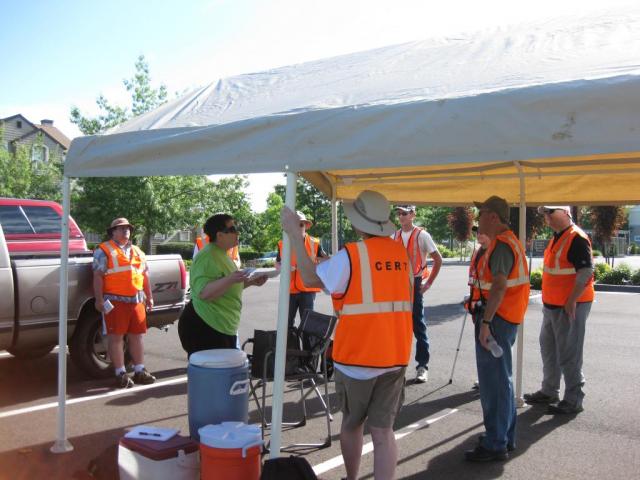ACT 2 Summary
On Saturday, July 10, 2010, Oregon ACES conducted their second Auxiliary Communications Test (ACT). To date, we have reports from most groups, showing a total of 59 individual participants. The focus of this event was integration of non-ham communications resources (such as CERT) into the response simulation. The exercise was very successful, again garnering overwhelmingly positive comments and including more people than before.
The full set of pictures is in the gallery.
The major players involved were:
| County/State | City | CERT |
|---|---|---|
|
|
|
The global Winlink radio email system was undergoing some routine maintenance which caused major issues for many of the participants involved. However, with some patience and persistence we were still able to move traffic as needed. There was even a station in eastern Washington monitoring the (simulated) events that pledged additional CERT personnel via a Winlink message. Way to go Chris!
The Tillamook County EOC was activated and used VHF, UHF, and HF voice, Winlink and D-Star, to exchange messages with participating groups including Lincoln and Washington Counties as well as the State OEM. Their specific exercise scenario required them to make contact with the City of Manzanita EOC who was activated to coordinate response with the local CERT Teams. In addition to this, they also handled simulated Health and Welfare messages between the counties. Within Tillamook, a portable Winlink/D-Star kit was taken to the county's Mobile Command Trailer positioned at a Search and Rescue training exercise involving 6 counties. Messages were exchanged from this location via all available modes.
An impressive showing from the Manzanita CERT and HAMsters teams brought 19 participants tasked with damage assessments of several structures and relaying injury reports. They tested the limits of their FRS radios, falling back to their amateur communicators when the distance between the teams became too great.
The City of Hillsboro activated their amateur radio stations at the EOC and their Water Operations Center. The EOC and Water Operations Center exchanged a few messages about equipment and operator status at the beginning of the exercise using the EOC's site repeater. The EOC staff then began to assist the CERT team in the field with damage reports, 911 calls, as well as health and welfare message traffic. Because the county EOC was not participating, the Hillsboro EOC had received permission before the drill to simulate backup operation for the county. This gave the Hillsboro operators an opportunity to practice using the equipment, software, and procedures required for interaction with the Oregon State OEM.
In addition to the EOC, the Hillsboro CERT team conducted a field exercise in the nearby neighborhood of Orenco Station. With 12 responding CERT members, they broke up into teams to canvas the neighborhood, communicating with FRS radios back to ham operators at a central location. The CERT team was given simulated damage assessments, 911 calls, and health and welfare traffic. They developed a communications plan and transmitted their traffic from various points in the neighborhood over FRS to be relayed via ham radio. Hillsboro CERT moved some 40 messages of various types over FRS and ham radio during the event.
In coordination with Hillsboro, the City of Beaverton's EOC ARU and Beaverton CERT Radio teams activated and exchanged health and welfare traffic destined for the adjacent cities. Like Hillsboro, the Beaverton team also sent 8 simulated 911 calls to WCCCA (Washington County's 911 center) with the assistance of the EOC amateur radio station. The city of Sherwood's EOC amateur radio station also worked to keep the 911 center busy by injecting traffic of their own.
A new participant in this ACT was the Oregon State Office of Emergency Management (OEM). The ARES/RACES unit that serves the OEM activated their station and took situation reports and Declaration of Emergency (DOE) messages over Winlink. The OEM ARU's participation in this gave the county-level stations additional much-needed practice in the procedures and forms required for that level of communication. Thanks to Vince and Marty for spending part of their Saturday to help with this.
As in ACT 1, the AC1ES station was active on HF for a quick net, taking checkins from participants in the area. Net control made contact on 80m with W7OEM, K7HIO, N7JDT, WA7MHB, and W7ONP on LSB voice.
The ACES development team will be working to define the date and scenario of the next ACT soon. Expect details for that event to be posted on the website in the near future. Again, thanks to everyone involved for making this another successful and valuable training experience!




 Subscribe via RSS
Subscribe via RSS